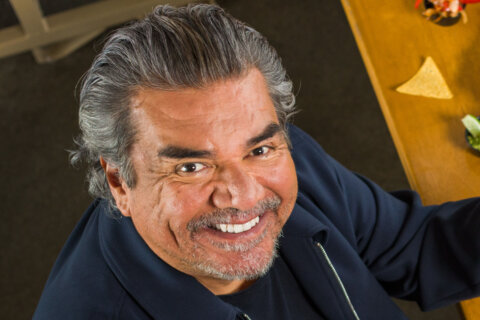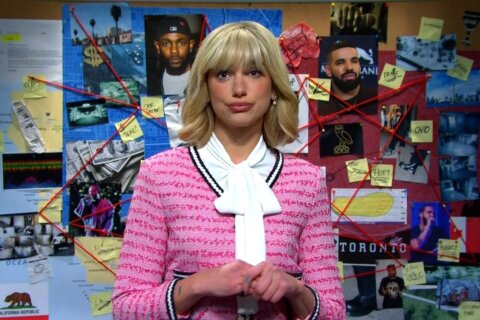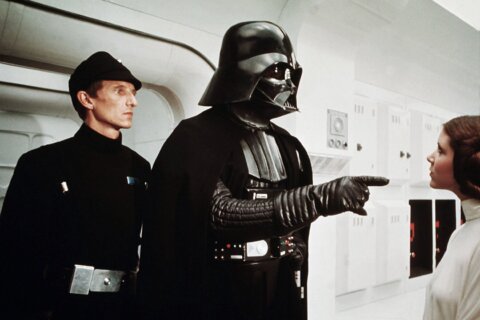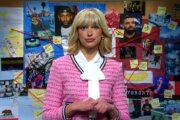WASHINGTON — Released just three years before his death, Walt Disney considered “Mary Poppins” (1964) to be his crowning achievement. Not only did it feature an Oscar-winning turn by Julie Andrews, it introduced more famous song-and-dance numbers than just about any other movie, making it the American Film Institute’s No. 6 Greatest Musical of All Time.
On Dec. 19, the Disney umbrella magically unfurls once more for “Mary Poppins Returns,” a wonderfully whimsical sequel thanks to a spot-on performance in the “spit-spot” title role and a surprisingly enchanting script that quips, “I was flying my kite and got it caught on a nanny.”
While “Saving Mr. Banks” (2013) told the “making of” story of author P.L. Travers, this film picks up decades after the original, as a grown-up Jane Banks (Emily Mortimer) helps her widowed brother Michael (Ben Whishaw) raise three kids (Pixie Davies, Nathanael Saleh, Joel Dawson). When a banker (Colin Firth) tries to foreclose on their London home, Poppins (Emily Blunt) saves the day alongside Burt’s chimney sweep apprentice Jack (Lin-Manuel Miranda).
Andrews’ shadow looms large. Her Oscar triumph remains one of the juiciest in film history, as her Broadway role of Eliza Doolittle was given to Audrey Hepburn for Hollywood’s “My Fair Lady” (1964) over concerns that Andrews wasn’t a big enough moviestar, only for Andrews to ultimately beat Hepburn as Poppins at the Oscars and land “The Sound of Music” (1965).
While these are big shoes to fill, Blunt somehow turns the inimitable into the imitable, crafting a stern yet mischievous heroine with a lovable vanity. “I’m never incorrect,” she says with a cheeky confidence. Even her wardrobe reflects who she is, crazy enough to mix prints and patterns yet formal enough to pull it off. To put it bluntly, she’s “practically perfect” in a performance worthy of her recent Golden Globe and SAG nominations, though I hope her eventual Oscar nomination comes for her more original, silent work in “A Quiet Place” (2018).
Likewise, Miranda is utterly charming as the chimney sweep who fondly recalls waving to Jane in the window every night on the streets of London. Miranda puts on his best British accent in a way that’s less over-the-top than that of Dick Van Dyke, whose charisma more than made up for it (look for his cameo!). Miranda even gets a chance to show off his “Hamilton”-style rapping, which young Disney fans will remember from the rapid-fire verses he wrote for “Moana” (2016). The result is his second Golden Globe nomination and his first for acting.
The familiar characters aren’t the only warm blankets of nostalgia. Other callbacks include a mirror reflection with a mind of its own, large items impossibly pulled from a magic bag and the talking parrot head of the umbrella, not to mention an eerily similar songbook.
It’s doubtful the new numbers will stand the test of time like the Richard and Robert Sherman tunes of the 1964 original. While “West Side Story,” “My Fair Lady” and “The Sound of Music” carried songs over from Broadway, “Mary Poppins” delivered numerous originals: “A Spoonful of Sugar,” “Jolly Holiday,” “Super‐cali‐fragil‐istic‐expi‐ali‐docious,” “I Love to Laugh,” “Chim Chim Cheree,” “Step in Time,” “Let’s Go Fly a Kite” and Walt’s personal favorite “Feed the Birds.”
However, director Rob Marshall (“Chicago”) finds visually inventive ways to stage the new songs by Scott Wittman and Marc Shaiman, who recently worked together on TV’s “Smash.”
It all kicks off with Miranda crooning under lampposts to “(Underneath the) Lovely London Sky,” which is this film’s version of Van Dyke’s soot-covered charmer “Chim Chim Cheree.”
Blunt then takes the children on a dazzling dive into the bathtub, which transforms into the cartoonish underwater world of “Can You Imagine That,” akin to “A Spoonful of Sugar.”
Like “Jolly Holiday,” the best number plunges into a mix of live-action and animation. When the kids break a ceramic bowl, they enter the painting on the side of the bowl, riding a carriage around the surface and fearing they’ll fall off. It all sets up the cabaret number “A Cover is Not the Book,” sending Miranda climbing a staircase of magically appearing books.
Soon after, Miranda sings “Trip a Little Light Fantastic,” which features a multiplicity of silhouetted chimney sweeps like “Step in Time” but runs a little long for its own good.
Meryl Streep briefly drops in as Mary Poppins’ zany cousin Topsy, who invites the kids into her upside-down living room for the wild romp “Turning Turtle,” the equivalent of “I Love to Laugh.” It’s a welcome reunion between Marshall and Streep after “Into the Woods” (2014).
It all culminates with another cameo by acting royalty, as “Beauty and the Beast” alum Angela Lansbury sings “Nowhere to Go But Up,” a soaring balloon finale like “Let’s Go Fly a Kite.”
While the songbook admirably creates new numbers, you’d rather go back and listen to the original favorites. The inherent lack of originality also applies to the plot, which not only echoes “Mary Poppins” but is also basically the same premise as “Christopher Robin” (2018) with its London fable of magical childhood friends coming back to mend cranky grownups.
“They called me back to look after the Banks children,” Mary Poppins says. “Us?” the kids ask. “Oh, I guess you, too,” Poppins replies, suggesting that she’s actually there to help the adults.
This theme is stressed before the climax when Michael has a moment of fatherly realization: “All this time I thought I was watching over them, but they were watching over me.”
This is the power of Blunt’s lullaby “The Place Where Lost Things Go,” its lyrics summing up the film: “Do you ever dream or reminisce / Wondering where to find what you truly miss / Or maybe all those things that you love so / Are waiting in the place where the lost things go.”
“Mary Poppins Returns” brings us back to the place of lost things. Thus, “A Cover is Not the Book” reveals a double meaning. It could mean that this “cover” song is not as strong as the original. Or, it could mean “Don’t judge a book by its cover.” In this case, both are accurate with a movie that surpasses expectations in an impossible task of reinventing a classic.









